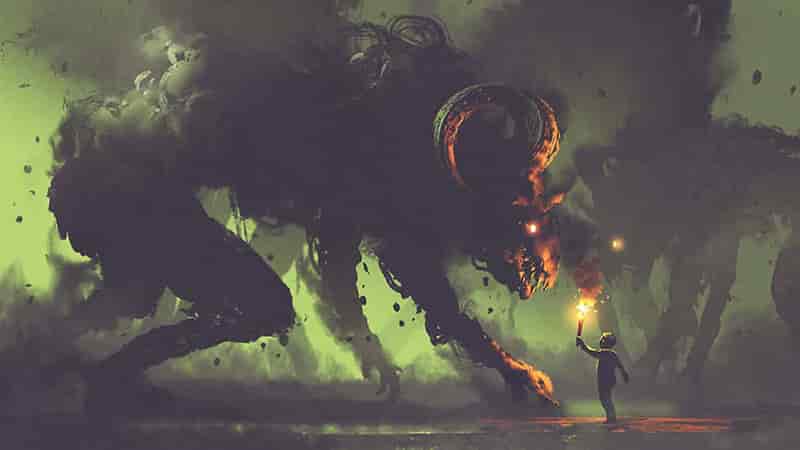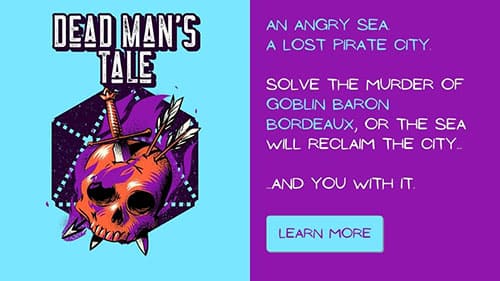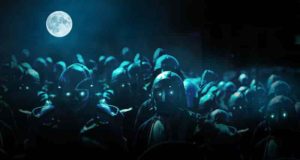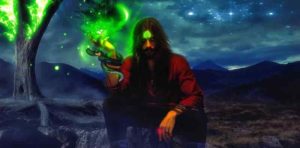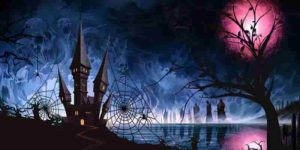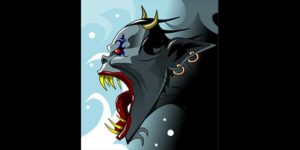Build and run a horror campaign for Dungeons and Dragons 5e or any other tabletop RPG with these storytelling elements:
- Include horror, tension and scares
- Build empathy and connection to characters
- Use the uncanny and unknown as a tool for fear
- Develop a spooky setting
- Build a significant threat
- Kill your player characters
Horror RPG’s are especially fun, like an interactive scary movie night. Think about it: every Halloween people flock to role playing haunted houses to be scared. Even the normies jump in on this fun.
Recreating this aesthetic is simple when you know the right tools. The truth is, it’s not complicated. The template is open to creativity, a skeleton (so to speak) of a story structure that can be painted in many different colors.
Some RPGs are built around this genre entirely, such as Monster of the Week, Vampire the Masquerade or Call of Cthulhu. Of course, D&D and Pathfinder have their fair share of horror adventures as well, played with a flare of party adventure. The scary stuff is popular, folks.
If you’re looking for someone to do the heavy lifting for you and just make a premade horror campaign, you’re in luck. Check out Dead Man’s Tale, an Island Pirate Adventure by clicking here or below.
Include horror, tension and scares
Scary can mean a lot of different things to a lot of different people. So, let’s breakdown some elements from thrillers, slashers, spooky spirits and terrors of the abyss. What fundamentally makes a story scary? What pulls players into the story and elicits that sweet, sweet adrenaline trigger?
Horror is made up of carnage, death and gross things in general. This is the primitive feeling of disgust and discomfort that comes from brutality, corruption or destruction. It’s the blood and guts, the shock and awe.
In a campaign, these elements can add a dimension of gore to a horror story, but don’t get caught up in only using gross-outs. I like to save some of my horror descriptors if and when a player character dies, giving them a final hurrah as they burst into a pile of organs. Or, consider using these descriptors on a monster reveal to add extra flavor.
Tension, on the other hand, is the magic that pulls players deeper into the scenario. As a GM, it’s our job to manipulate our players. More specifically, I mean manipulate our players’ feelings. Tension is the grey area of the story, a hint at the danger to come. If we can build on this tension, the reveal will be so much more impactful.
Give the scary aspects of the story some room to breathe, only hinting at the existence of the threat in subtle ways. Four teens finding a dusty old book full of spells written in blood sets up possibilities. What happens when they read from it? What if Tiffany thought it would be cute to draw a pentagram on the floor while you read?
The scares come after or during the tension. Any moment a player is on edge with an unknown danger is a perfect moment to drop a sudden explosion of action. Scares play on the unexpected, which can be easier to pull off in other forms of storytelling. That said, adding these surprises into the RPG can help shake up the story.
Remember the senses
Horror is a genre of visceral action and primitive feelings. This is a part of what makes it so much fun. So, be sure to include as much sensory information as possible.
Sight is an obvious example: you see a shadow in the corner or another face in the mirror. Most of the worldbuilding will be sight-based, and tension can be built on what isn’t seen. But, let’s take a look at how we can utilize the other four senses.
Sound is an effective tool for building tension. If the players can hear scratching at the door, the next question is what was that? As we’ll learn in the threat portion of this article, we don’t want to show our monster too early. Build hints, like heavy breathing, crunching leaves, disembodied whispers, to get the players on the edges of their seats.
Smell and taste are often useful for gore. These are the gross out senses, so use sparingly depending on your group. That said, feel free to incorporate these senses to build tension as well. A Sulphur smell or the stink of a skunk ape could signal danger without exposing the source.
Then, there’s feelings. Obviously, physical touch could be implemented. A character could feel breath on their neck or a scratch from an invisible assailant. However, don’t forget inner feelings as well, such as instinct. Players may even roll certain checks to investigate the spooky scenario. Use successful skill checks as an opportunity to drop in uneasy feelings.
Related Posts:
Guide to Building a Zombie Apocalypse: DnD 5e
| Guide to Building a Necromancer Wizard: DnD 5e
|
Build empathy and connection to characters
This tip is borrowed from writing in the horror genre. Think about how often scary movies include parties, young adults and good times. All while a threat lurks in the distance. Sure, the kids are stupid and up to no good, but they’re still kids.
If we are to care about a character’s fate, we need a good reason. Spending time with the characters in a fun setting can increase this feeling. Imagine you’re hanging with your friends, drinking a few beers, when suddenly a masked killer kills Tommy. It’s horrifying. It’s the ultimate crap-your-pants moment.
As is the case with most horror tropes, this is used to build tension. For players who enjoy the role-playing side of tabletop RPGs, this is a great moment to get into character. Encourage your players to goof around in character for a little bit. Then, tease out the scary stuff. Something isn’t right, something bad happened, something just killed Tommy—that whole build-up.
Use the uncanny and unknown as a tool for fear
Fear can mean different things to different people, so let’s break down some fundamentals.
What makes a situation scary? We know that somewhere deep down in our ape brains it breaks down to survival, but that doesn’t quite explain the details. For centuries, horror writers and storytellers have perfected these details. Two elements stuck out as clear winners in the creep contest: the uncanny and the unknown.
The uncanny means a situation, object, surrounding or person is off from what it should be. It’s a peculiar sensation, like something in your gut is telling you to run away. What makes dolls and clowns so creepy? They play with what a human should look like. Dolls look like people, but don’t have that spark of life (or shouldn’t, at least). Clowns paint outlandish expressions on their faces, something we subconsciously use to relate to other people.
This sensation can have broad examples: a black cat passing by too many times, birds falling silent in a forest, a stranger that’s a bit too friendly.
On the other hand, the fear of the unknown haunts us all the time. This simply means a situation unfamiliar us is playing out. We could end up dead in a number of horrible ways, and information about our surroundings is key for security. When this is taken away, our minds can go bananas with imagined possibilities. As the saying goes: it’s not that we fear the dark itself—we fear what could be lurking in the dark.
Giving your players situations that don’t make sense to them can spike up the sensation of fear.
Develop a spooky setting
Building a horror setting should be a fun exercise in creativity. We all know creepy elements of a place that send chills down our spine. Building on what we’ve gone over so far, we can build a setting that brings the fear to life.
First, let’s take a look at a few classic horror settings.
Haunted houses are classic. Whether it’s an abandoned shack at the edge of town or historical mansion with decades worth of ghosts haunting its walls, we can build up the spook factor. Consider elements of the uncanny: a statue moving its head, strange relics on a desk, voices where they shouldn’t be. Think of the musty smells and eerie creaks of old setting buildings. What’s knocking around in the cellar?
The wilderness at night is another great example, linking us to fireside ghost stories and the mystery of the wild. Elements of the unknown can be used to great effect in this setting. Who knows what’s lurking in the bushes where the campfire light dwindles? We can build on the small sounds that occur naturally. Maybe it was bigfoot, maybe a raccoon.
Metaphors and similes of death, corpses and the grotesque are often used to invoke a sense of decrepit surroundings. An old house could be locked up like a coffin. A tree can be crooked and skeletal. A cave could smell like rotting flesh. Get poetic and see what happens.
Build a significant threat
To build tension, our killer, monster or ghost needs to be a serious threat. This is the case with most tabletop RPGs in the genre, but it’s important to reiterate this point to heroic games as well. Sure, D&D and Starfinder have “monsters”, but that can turn technical, like a video game. Do I smash button? Do I get prize?
If we want our players to feel the sensation of fear, we have to bring it. This means the threat must be lethal. Our players need to feel like they’re not entirely in control. Remember to choose monsters accordingly.
This could be challenging for games with warrior or wizard characters. Having superpowers can cause a dampening effect on the fear factor. But, remember everyone has blind spots. Think about the movies Predator and Aliens, there’s always a way to place a tough guy in a scenario outside of their control. The trick is to use an even meaner monster.
If you want to build your own custom monster, you can borrow some of these:
Scary Fairies: Fae Folklore Explored
Make a threat and hide it
Now that we have our threat fleshed out, we need to add a dash of fear. More precisely, we need to add the element of the unknown. We need to signal that the threat is lurking in the shadows, ready to catch its next victim on its own time. Then, we can move to the uncanny when we finally reveal the horror later in the story.
Horror movies have utilized this trick for decades, most famously in Jaws and Alien. It’s a mental game that allows the viewers’ imaginations to run wild. People are best at scaring themselves.
Let the threat stalk in the shadows for a while. You can utilize tricks learned in mystery RPGs (find my article here) to great effect. The players can pick up clues and hints to the horror as the story progresses. The tension builds, players are aware of the carnage possible, and they know they’re right in harm’s way.
Consider one monster
Playing a horror/thriller with one threat can be helpful in building stories that scare. If our players can feel intimidated by 1 monster, we’ve done what’s necessary to build tension, etc.
Consider the zombie genre. I love zombies, and sure, they’re gory and out to eat me, but zombie hoards these days feel a little overplayed. It’s kind of like swatting meat puppets around when our player characters are armed with swords or guns or spells.
Now, I’m not saying you can’t make a great scary story with zombies. But, maybe master the art of tension and threat-building first. The zombies will be much more threatening then.
Kill your player characters
This isn’t your typical loot and pillage dungeon raid. For the stakes to be real, the players have to be willing to allow their characters to die. We should definitely state this to everyone before playing.
Sure, it can be a weird situation if suddenly a player can’t play the game anymore. So, think of ways for the dead players to get back into the game. Maybe allow for new characters to join as the story progresses, so players can jump back in as someone else. Or, dead players can help the GM create new ways to cause mayhem. We can get creative.
Let me know what you think? Are there any other tricks to create fear?
Check out more spooky articles:
Guide to Building a Haunted House Adventure: DnD 5e
| Guide to Building a Warlock Fiend Patron: DnD 5e
|
Disclaimer:
Genre Bomb is unofficial Fan Content permitted under the Fan Content Policy. Not approved/endorsed by Wizards. Portions of the materials used are property of Wizards of the Coast. ©Wizards of the Coast LLC.

